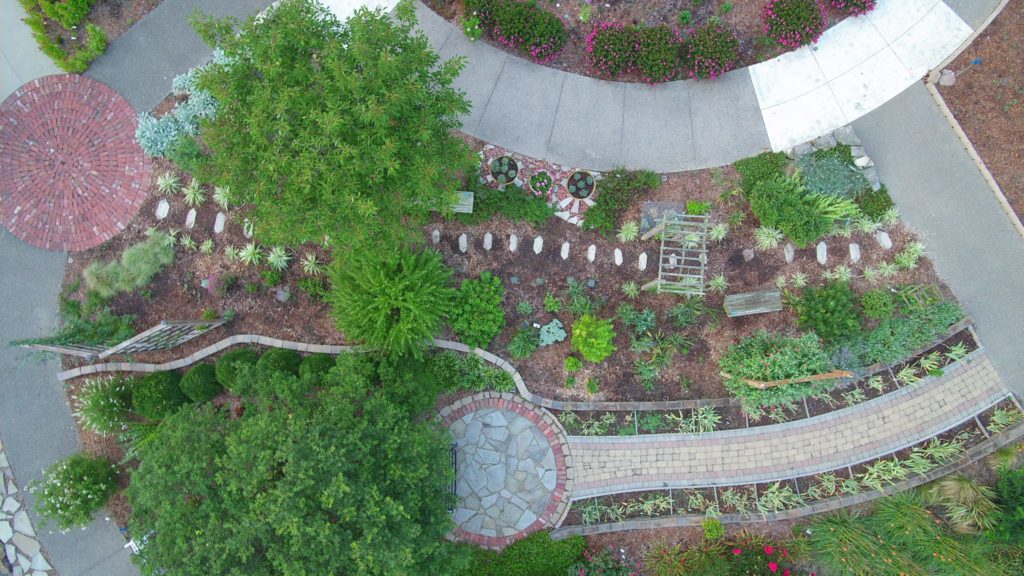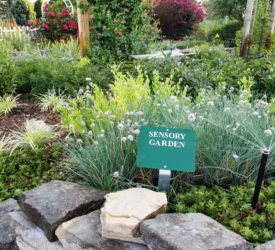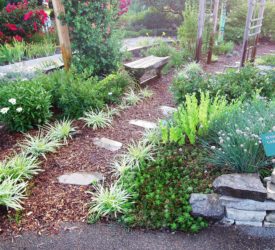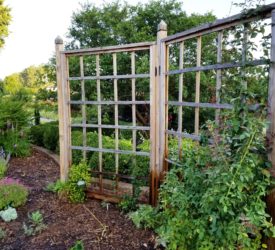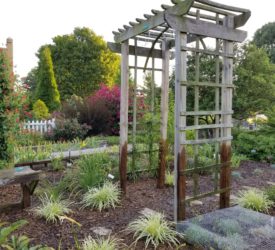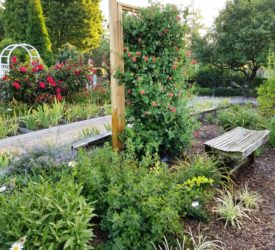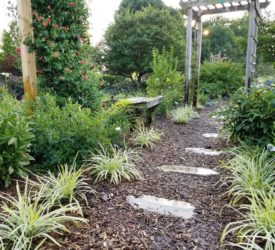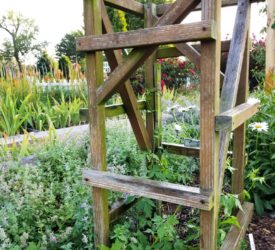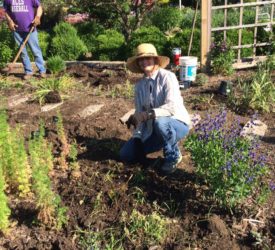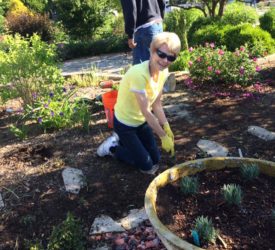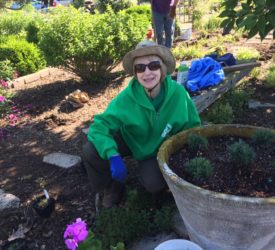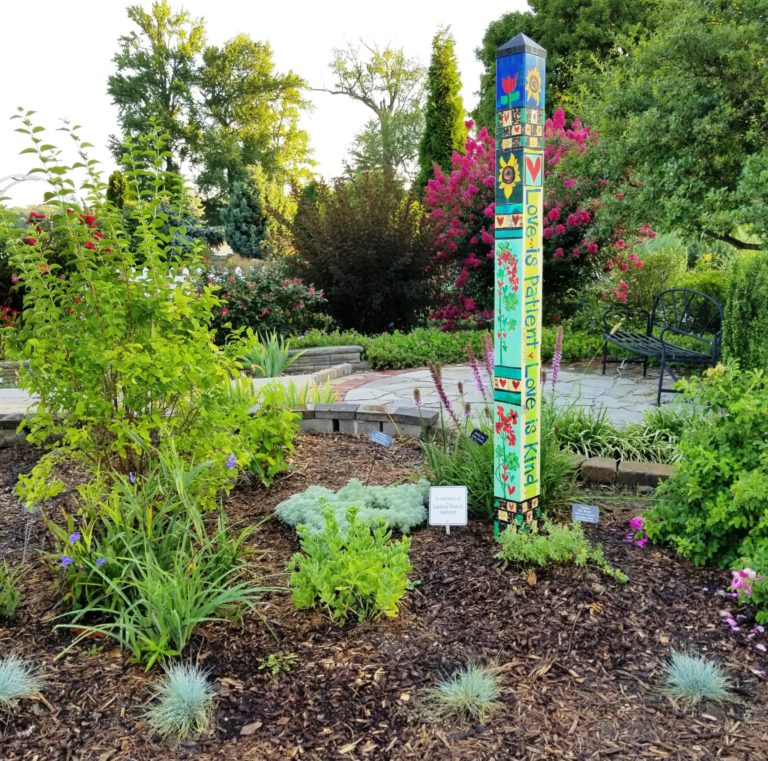 Sensory Garden
Sensory GardenLocated on the eastern end of the Display Garden, the Sensory Garden is designed to be accessible either by the walking stone pathway, which takes you into the garden, or by the paved trail featuring raised berms to allow wheelchair visibility. The plant selection and presentation can allow even those with vision impairment to experience the wonders of and pleasures of plants. Trellises hold plants high for improved display and better growing conditions.
Sensory gardens incorporate plants and other features to create an environment that reaches out and invites you to come in, relax, and take time to appreciate your surroundings. Benches within the Sensory Garden welcome you to sit and fill up your senses.
Sight: Plants have been chosen to provide an array of colors throughout the seasons. Depending on what time of year it is, you may see the blues of love-in-a-mist and larkspur; yellows of daffodils, orange of honeysuckle in summer and Fragrant Sumac in the Fall of the year; pinks of peonies and rose campion and geraniums; purples of lilac, catmint, butterfly bush, clematis, and lavender; whites of love-in-a-puff; silver in Artemesia ‘Silver Mound’ and all shades of green and grey in grasses, herbs, stonecrop and lamb’s ear.
Sound: Block out the sounds of the traffic and listen for the sounds coming from the garden. Hear the birds singing, the bees buzzing, the wind blowing through the grasses and the seeds rattling in their pods. Shake the pods of Love-in-a-Puff to hear the seeds rattle in the autumn. Listen for the chime of hanging crystals in the arbor adding to the sound.
Smell: In the spring, smell the hyacinths in bloom. As the seasons change so do the scents around you…the sweet fragrance of lilacs and honeysuckle; rub the leaves of the anise hyssop for the scent of licorice; the assorted herbs – the scent of rosemary, the various mint, sage, and scented geranium.
Touch: Feel the softness of the leaves of Lamb’s Ear and Silver Mound. Contrast the leaves of the various herbs – some are prickly, some smooth, some rough. Feel the thick, smooth leaves of the various succulents: sedums, hens and chicks, stonecrops.
Taste: ONLY WHERE NOTED AND UNDER SUPERVISION!
Herbs are grown for the taste they add to many dishes. Mint is used as a tea and flavoring for sweet and savory dishes. Look for it around the planters. The sweet taste of honeysuckle attracts hummingbirds. Lavender is used as a flavoring in French cooking from the area of Provence.
SPANISH TRANSLATION:
Jardín Sensorial
Coordinado por Jane Leingang
Situado en el extremo oriental del MGDG (jardín de exhibición de los maestros jardineros), el Jardín Sensorial está diseñado para ser accesible por el sendero piedra que lleva al jardín, o por el sendero pavimentado, y tiene bermas elevadas para permitir la visibilidad desde las sillas de ruedas.
La selección y presentación de las plantas permite que incluso aquellos individuos con impedimentos visuales experimenten las maravillas y los placeres de las plantas. Los enrejados mantienen las plantas altas para permitir una mejor visualización y mejores condiciones de crecimiento.
Los jardines sensoriales incorporan plantas y otros elementos para crear un ambiente que atrae e invita a entrar, relajarse y tomarse el tiempo para apreciar el entorno. Los bancos dentro del jardín sensorial le dan la bienvenida para sentarse y llenar sus sentidos.
Vista:
Las plantas han sido elegidas para proporcionar una variedad de colores a lo largo de las estaciones. Dependiendo de la época del año que sea, puede ver los azules de la ajenuz ( Nigela) y de la espuela de caballero (larkspur); los amarillos de narcisos, el naranja de las madreselvas en verano y el zumaque (Rhus Aromatica) en el otoño; los rosados de las peonías, claveles lanudos y geranios, el purpura de las lilas, la menta, el arbusto de la mariposa, el clematis, y la lavanda; el color blanco de los farolitos, el plateado de la Artemisa “Montículo de Plata” y todos los tonos de verde y gris en pastos, hierbas, abeto español (Sedum Hispanicum) y orejas de cordero.
Sonido:
El Jardín sensorial está diseñado para bloquear los sonidos del tráfico y escuchar los sonidos que vienen del jardín. Escuche los pájaros cantando, las abejas zumbando, el viento soplando a través de los pastos y las semillas vibrando en sus vainas. Sacuda las vainas de los farolitos para oír como caen las semillas en el otoño. Escuche el timbre de los cristales colgantes en el jardín que añaden su melodía a la sinfonía de sonidos del Jardín Sensorial
Olor:
En primavera, huela a los jacintos en flor. A medida que las estaciones cambian también cambian las fragancias a su alrededor… el perfume dulce de lilas y madreselvas; el olor de regaliz al frotar las hojas del hisopo anisado, las fragancias de las hierbas aromáticas como el romero, la menta, y la salvia, y el aroma del geranio perfumado.
Tacto:
Sienta la suavidad de las hojas de la oreja de cordero y de la artemisa “Montículo de Plata”. Contraste las hojas de las diversas hierbas – algunas son espinosas, algunas suaves, otras ásperas. Sienta las hojas gruesas y lisas de las plantas suculentas como los sedums, gallinas y pollitos, y abeto español.
Sabor:
¡SÓLO DONDE SE INDICA Y BAJO SUPERVISION!
Las hierbas se cultivan por el sabor que agregan a muchos platos. La menta se usa como té y como saborizante para platos dulces y salados. Encuéntrela alrededor de las jardineras. El dulce sabor de la madreselva atrae a los colibríes. La lavanda se utiliza como aromatizante en la cocina francesa de la zona de Provenza.

